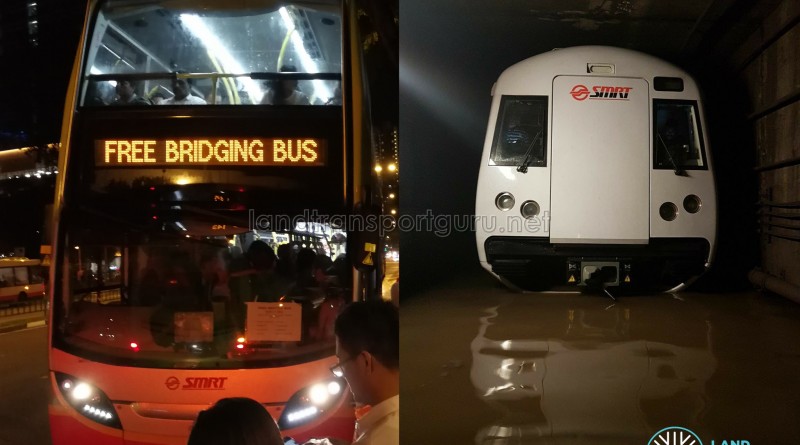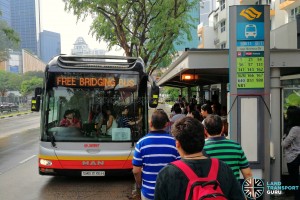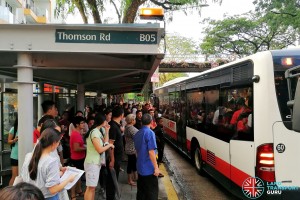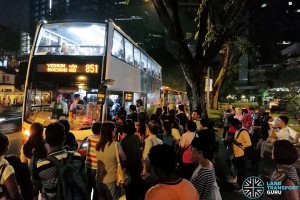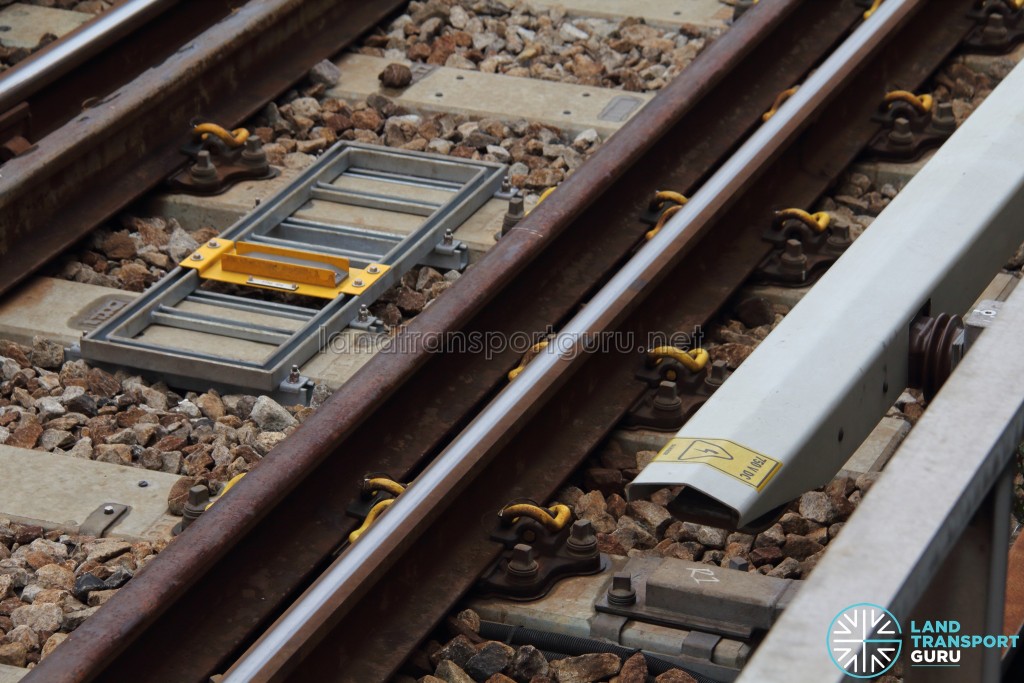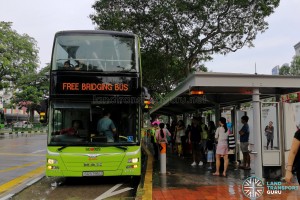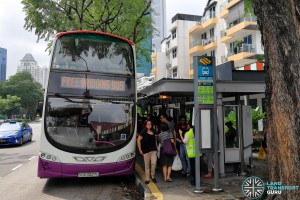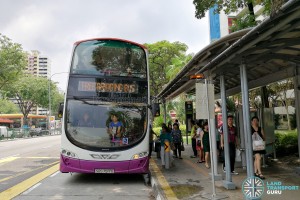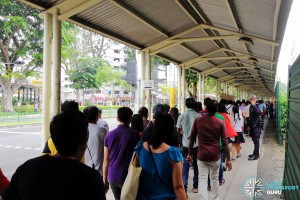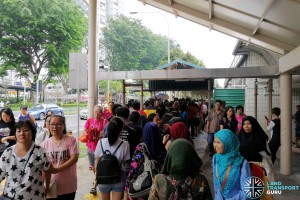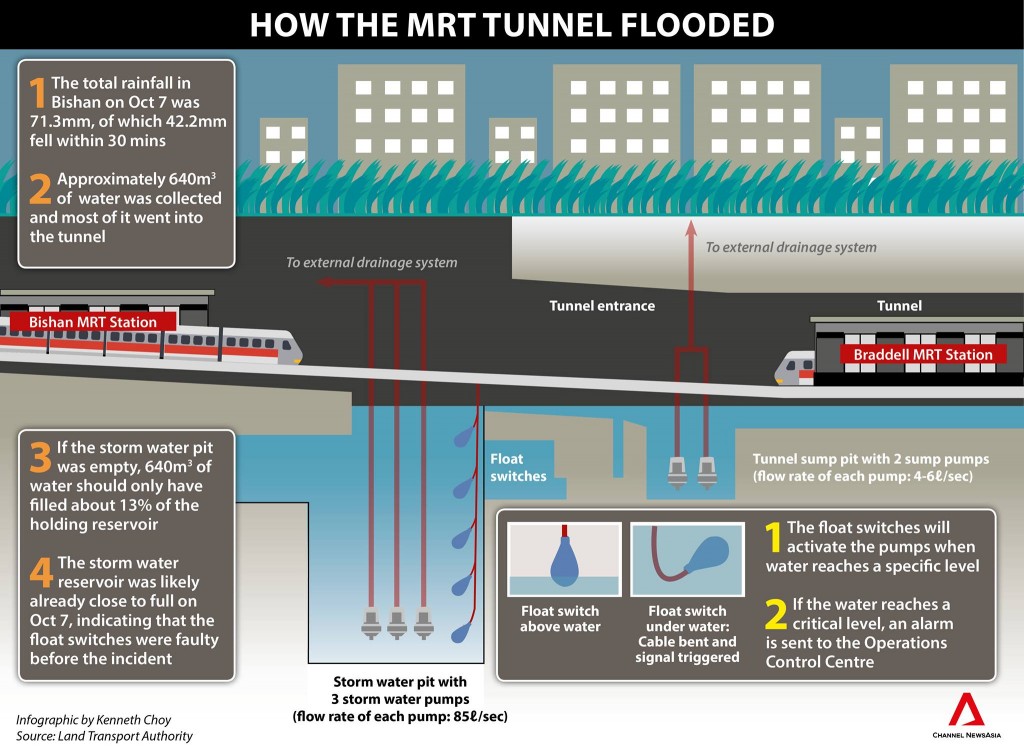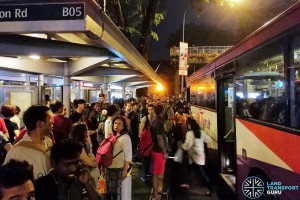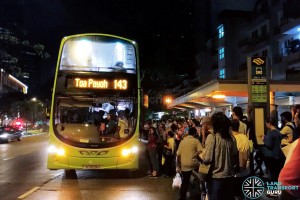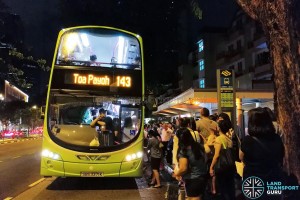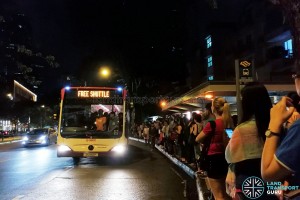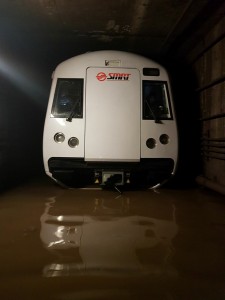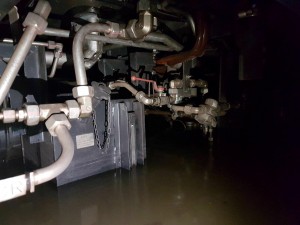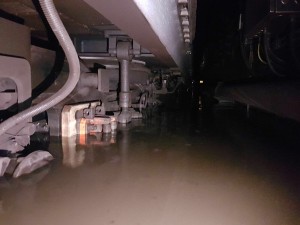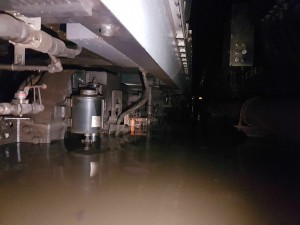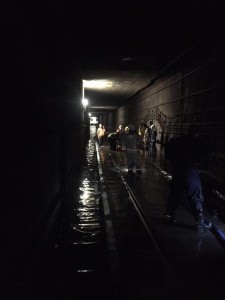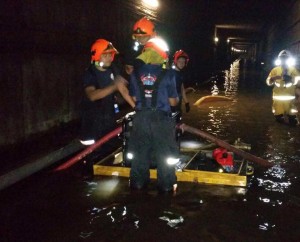| Bishan MRT Tunnel Flood |
|
 |
|
| Date / Time | 7 October 2017 |
| Location | Between Braddell and Bishan MRT Stations |
| Rail line | North South Line |
| Operator | SMRT Trains |
| Type of incident | Flooding of northbound and southbound tunnels within the deepest section of tunnel |
| Cause | Failure of automatic flood prevention measures arising from maintenance lapses |
| Injuries | None |
The Bishan MRT Tunnel Flood disrupted North South Line train services for 20 hours on 7 – 8 October 2017. Flood waters up to 1 metre deep and 100m long in tunnels rendered the stretch of tracks between Braddell and Bishan stations impassable.
A small trackside fire, unrelated to the incident, occurred on the same day between Raffles Place and Marina Bay MRT stations. However, the fire died out by itself before emergency services could intervene.
The incident was caused by maintenance lapses of an anti-flooding system, which resulted in the failure of a storm water pump. Torrential rain filled up the storm water pit, and overflowed into the tunnels.
The incident ranks among the most severe train disruption of 2017. Prior to this incident, the North South Line has been hit by many signalling faults arising from the new CBTC signalling system.
Approximately 250,000 commuters were affected by the disruption. Public buses were overcrowded as a result, and traffic congestion was widespread, as commuters hurried to find alternative transport. Regular and bridging buses were insufficient to cater to the crowds. Train services resumed at 1350hrs on Sunday, 8 October 2017.
Timeline:
7 October:
- 1500hrs – Large amounts of rainfall were recorded across Singapore.
- 1733hrs – First reports of train disruption between Bishan and Toa Payoh towards Marina South Pier.
- 1755hrs – Small fire spotted at the tunnel trackside between Marina Bay and Raffles Place stations.
- 1745hrs – Train service suspended from Ang Mo Kio and Toa Payoh stations. Free bus boarding and free bus bridging services are announced.
- 1805hrs – Train service suspended between Ang Mo Kio and Marina South Pier stations in both bounds. Free bus boarding and free bus bridging services extended.
- 1905hrs – The Singapore Civil Defence Force (SCDF) receives a call from SMRT requesting assistance for a flooding situation in the tunnels between Braddell and Bishan MRT Stations.
- 2130hrs – Train service resumes between Orchard and Marina South Pier. Train services between Ang Mo Kio and Newton stations remain suspended until end of service hours.
- Overnight recovery works to clear water accumulated in the tunnels
8 October:
- 0515hrs – Start of revenue service, train services between Newton and Ang Mo Kio remain suspended. Free bus boarding and free shuttle bus services available between Newton and Ang Mo Kio. A projected time of 9am was set for end of recovery work.
- 0832hrs: SMRT announces that recovery work would require more time. Train services suspended until further notice.
- 1009hrs – SMRT announces that the water in the tunnel is “almost cleared”
- 1100hrs – Water in tunnels completely cleared
- 1350hrs – Train services resumed.
Background
The North South Line is the first MRT line to be built in Singapore. Train tracks run both overground and underground, exposing train equipment to the elements. During inclement weather, trains drive more cautiously and operate at a slower speed. Proper drainage systems with water pumps are in place within all tunnels to allow for the drainage of accumulated water, especially in a sector such as that between Bishan and Braddell stations train where tracks run from overground to underground.
The North South Line connects commuters between the city and many residential estates in the North, namely Ang Mo Kio, Bishan, Toa Payoh, Woodlands and Yishun. The affected sector, from Ang Mo Kio to Novena, is a critical city-town transport link. Large crowds of stranded crowds could only rely on buses and taxis to travel northbound.
Trains draw power from a third rail electrified at 750V DC. During a flood, this source of live electric current will inevitably pose a danger to engineers, and traction current needs to be switched off to permit engineers to access the location of flooding. Apart from the third rail, many other trackside components (e.g. signalling and power infrastructure) mounted to the tunnel floor might also sustain damage. Furthermore, many crucial train-borne components are located underneath the passenger cabin, such as traction motors and power equipment, that would likely malfunction when submerged.
Flood Causes
Torrential rain entered the tunnels through the portal opening near Bishan MRT station, where aboveground rail tracks transit underground. Under normal circumstances, rainwater runoff accumulated in the adjacent storm water sump pit would have been siphoned off by a system of pumps. However, the water pumping system malfunctioned and resulted in rainwater overflowing from the storm water sump pit into the tunnel opening. The water accumulated at the lowest point of the tunnel, between Bishan and Braddell stations. Trackside power supply was deactivated for safety.
Investigations revealed that a faulty float switch was behind the pump failure which led to the tunnel flooding. The electrical switch is attached to a flotation component which rises when water is present, and turns on the pumps when sufficient water has accumulated.
Maintenance Lapses
Internal investigations by SMRT revealed that the Bishan flood protection system had not been maintained for many months prior to the incident. Maintenance records for December 2016, March 2017 and June 2017 were falsified, as they did not match corresponding logs for track access and pump activation.
13 staff were found responsible for failing to maintain the system, and some staff were found to have falsified records. 8 staff were sacked, 1 was demoted, and 2 received disciplinary action.
Recovery
The Singapore Civil Defence Force and PUB worked overnight on 7-8 October alongside LTA and SMRT officers to clear the water, with SBS Transit also on standby to support the recovery efforts. Affected trackside equipment was subsequently inspected, cleaned, replaced and tested before passenger services resumed.
During the service disruption, free regular bus and bus bridging services were activated promptly for affected commuters. More than 40 buses from SMRT and SBS Transit were deployed to provide bus bridging services. Information was also made available at stations and updates provided on the SMRT website and Facebook; LTA and SMRT Twitter accounts; LTA Traffic News and MyTransport.SG.
SMRT spent about $2 million in total on repairs and replacement of equipment.
Follow Up Action
To prevent a repeat occurrence, checks of other storm water pump systems at four other tunnel portal locations at Redhill, Kembangan, Lavender and Changi were carried out. 2 out of 8 pumps at Kembangan and 3 out of 4 pumps at Lavender were found to be not in serviceable condition.
Bridging Buses
7 October:
SMRT Buses activated the North South Line Free Bridging Bus Service between Ang Mo Kio and Toa Payoh initially at 1745hrs, after the train service disruption notice was issued at 1735hrs.
At 1805hrs, when the disruption extended North South Line stations between Ang Mo Kio and Marina South Pier, the destinations of the bridging buses were adjusted accordingly to cover all stations affected by the disruption.
Commuters observed that northbound bridging buses were insufficient – the first bridging bus at Newton towards Ang Mo Kio only arrived at 1945hrs. Many bridging buses also operated in bunches, as many as 6 buses in a row, as drivers were not familiar with the bridging bus service route.
At 2305hrs, bridging buses were shortened to ply between Ang Mo Kio and Orchard Stations, after train service resumed between Marina South Pier and Newton at 2130hrs.
SBS Transit also deployed several buses to ply the Bridging Bus Service route between Ang Mo Kio and Toa Payoh.
8 October:
On the morning of 8 October, bridging buses were deployed to cover the affected stretch of line between Ang Mo Kio and Newton, until the resumption of train service in the early afternoon.
Established cause
Reproduced from Land Transport Authority’s Press Release, 17 October 2017
“Update on LTA Investigations into the North-South Line Service Disruption on 7 and 8 October 2017”
Investigations by the Land Transport Authority (LTA) have revealed that a combination of factors caused the flooding in the tunnels between Bishan and Braddell MRT stations on 7 October 2017. The accumulation of water in the tunnels caused regular train services on both bounds of the North-South Line between Ang Mo Kio and Newton MRT stations to be disrupted, from about 5.30pm to 12.28am on 7 October 2017 (close to 7 hours), and from 6.02am to 1.36pm on 8 October 2017 (about 7.5 hours).
Existing flood protection measures
2. Two key flood protection measures are deployed at MRT tunnel portal entrances. First, large storm water pits collect excess rainwater before they can flow into the tunnel entrances. The storm water pit at Bishan has the capacity of about two Olympic-sized swimming pools, and can contain about six hours of continuous heavy rain.
3. Second, the storm water pits are equipped with multiple pumps that siphon water to an external drainage system. These pumps are controlled by a series of sensors (also known as float switches), which automatically turn the pumps on when water reaches specified levels. Should water rise to a critically high level, a separate “alarm” switch (“high water level” switch) would trigger an alarm at the Operations Control Centre (OCC). This would alert duty officers who can then investigate the cause of the alarm, and activate additional measures if necessary (see Annex for switch diagram).
Likely Causes of the Incident
4. Under normal circumstances, rainwater collected by the storm water pit would have been pumped away as soon as water levels rise above the float switches, activating the pumps. On 7 October, all pumps failed to automatically activate despite water reaching very high levels. Subsequent checks found that the pumps in the storm water pit were all in working condition. The root cause of the flood is therefore likely due to failure of both the “stop” and “alarm” float switches. The “stop” float switch had remained open instead of closing when the water level in the storm water pit rose above it, preventing all the pumps from being triggered. The “alarm” float switch also failed to send a warning alarm to SMRT’s OCC when the water rose above it, preventing the OCC from reacting before the flooding occurred. As a result, water accumulated in the storm water pit and eventually overflowed into the tunnels.
5. Based on rainfall data for 7 October, the total volume of rain water collected by the catchment area around the Bishan tunnel portal entrance was approximately 640m3. Had the storm water pit been empty, this volume of water would have only filled about 13% of the pit. Hence, it is likely that the storm water pit was close to full on 7 October – which points to the likelihood that float switches were faulty even before the incident. During recovery efforts, it was also observed that sludge and debris had accumulated in the lower compartment of the Bishan storm water pit, where the pumps and float switches are. This could have affected the effective operation of the float switches.
Safeguards to protect commuters
6. For the safety of commuters, the OCC had switched off traction power to affected tunnel sectors as soon as the flooding was detected. Even if the flooding had gone undetected and water levels had risen to the power rails, built-in safety features would have kicked in to automatically cut the power supply to the tracks. SMRT had also swiftly taken action to halt train services as soon as flooding was detected, to ensure the safety of commuters. Commuters were de-trained at stations and no passengers were on the train that stalled in the tunnel.
7. Said LTA Chief Executive, Mr Ngien Hoon Ping: “LTA takes a serious view of these public transport service disruptions, which are understandably disheartening when they occur. Our commuters are at the heart of our public transport system, so we must work together and do all we can to prevent a recurrence.”
Gallery:
Gallery (Online photos):
Initial photos of the flooded tunnel first surfaced online, likely taken by a member of the recovery crew:
After train services resumed on Sunday morning, the SCDF also posted photos of the flooded tunnel:
Video:
References
- “Water in the tunnel, trackside fire caused train disruption on NSL: SMRT”, Channel NewsAsia
- Update on LTA Investigations into the North-South Line Service Disruption on 7 and 8 October 2017
- Parliament: SMRT spent $2 million on repairs, replacements after Bishan flooding. The Straits Times
- Cover photo – Left: Free Bridging Bus, Land Transport Guru, Right: MRT submerged in floodwaters, unknown (circulated on internet)
